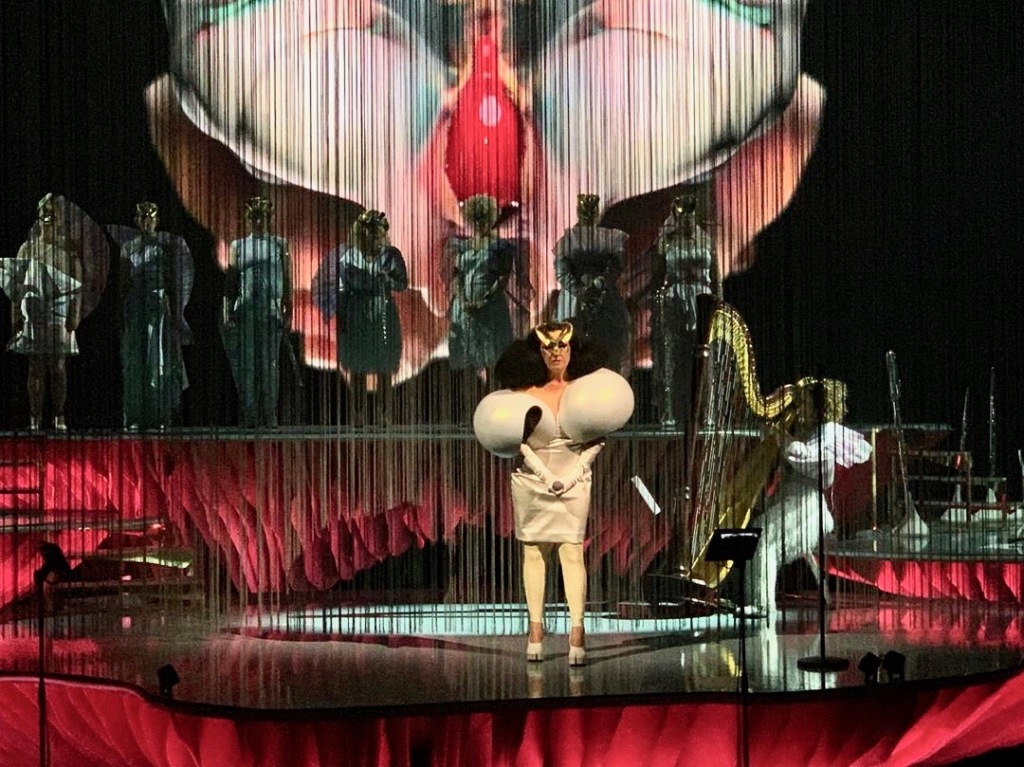When Bjork’s Utopia was released in 2017, the album stood in stark contrast from her previous effort, Vulnicura. While the latter was a break-up album so frank and grueling it forced her to cancel several tour dates, former is a tenderly optimistic pastoral relishing in hope for the future. Despite being postponed due to the pandemic, Cornucopia manages to be even more timely in 2022.
Through intricate masks and grandiose, silhouetted garments unique to each performer, the cast are transformed into hybrid creatures inhabiting the space between faun and elf, alien and insect. Bjork’s costume, a fitted black jumpsuit under a layer of loose netting adorned with tulle orbs (think loofah dress but made by Iris Van Herpen), makes the singer stand out among the dancers, but she generously shares the stage with every other artist in the production—which, for the LA dates, included a local California choir.
It is a testament to Bjork’s attention to detail and grand vision that for most of the show, I found myself not looking at her, but observing every intricate part of the performance. At any given point, there were choir members dancing and flutists frolicking, musicians rocking out on electronic keyboards or drums, and hypnotizing visuals projected in conjunction with deliberate shocks of light blasted at the audience. It’s not chaos and it’s not rote choreography—rather, each artist onstage dances to their own drum, egged on by Bjork’s own swaying between fits of stomping and punching the air. The effect is an experience more akin to theater than a usual recording artist-fronted concert. Cornucopia is a living, breathing universe presented as a multimedia performance art show.
The show opens, interestingly enough, with a choral rendition of a deep cut from Vulnicura. The final verse in “Family” speaks of a “universe of solutions,” which provides a segue into the themes explored throughout Cornucopia: motherhood, rebirth, and imagining life anew. The show’s message recontextualizes Bjork’s piece about the rupture of her marriage into a macro-scale lament on the state of the world, specifically pertaining to the use of fossil fuels and the role they play in climate change.
Cornucopia’s visuals are at once otherworldly and inherently earthly. Through projectors, lights, and a series of translucent curtains serving as screens, the show blurs the line between the digital and the organic. During “Body Memory,” images of writhing figures are projected at the same level as the choir and flutists, giving the illusion of projections come to life, while at other times every performer sways in unison like individual blades of grass. A particular highlight of the synergy between the auditory and visual comes early in the show when an image of a flower blooming and un-blooming is looped on-screen while spotlights dilate and illuminate the audience for a brief moment before fading in unison with the blooms. The experience evokes birth in all its forms; the line between flora and fauna becomes blurred as the moving art segues into a sequence evocative of traveling through the birth canal. Is the tunnel framed by nerve endings or roots? In Bjork’s Cornucopia, there is no difference. The personal is universal. The floral is mammalian.
This same level of nuance is applied to the sonic landscape. Onstage is a womb-like vocal booth where Bjork and a couple of vocalists retreat to for certain numbers, like “Mouth Mantra,” where the resonance of the vocals plays a key role in the experience. Rather than create echo, the booth enriches the vocals by capturing them from discrete microphones placed before and around the singers. Later, Bjork exits the sonic cave to stand center stage, surrounded by four flutists together playing a single, circular flute around five feet in diameter. The circle seems to represent the cyclical nature of life, while the joint endeavor to play the four-person instrument portrays the need for community efforts in creating our own utopia on Earth.
These ideas woven throughout the show come to a climax in “Sue Me” and “Tabula Rasa,” where Bjork explicitly confronts intergenerational trauma and her intention to not pass it onto her daughter. In the context of Cornucopia, this touching message of mindful motherhood becomes an admonition of conscious ecological stewardship, further punctuated by a message from activist Greta Thunberg. In the recording, Thunberg imagines what the world will look like in the year 2078, when she will celebrate her 75th birthday. It is a potent reminder that our activism or lack thereof directly affects future generations; climate change is the trauma of the Earth, and Bjork and Thunberg urge us to acknowledge it.
The idea of a better future is further explored by the lyrics of “Future Forever.” Bjork emerges for the show’s encore in a sparkling white dress constructed to give her the appearance of a flower shedding its petals and sings, “Your past is on a loop. Turn it off. See this possible future and be in it.” It’s a subdued yet triumphant rebuttal against climate pessimism. “Watch me form new nests. Weave a matriarchal dome,” she sings, reveling in her creation and inviting the audience to create utopia for themselves.
